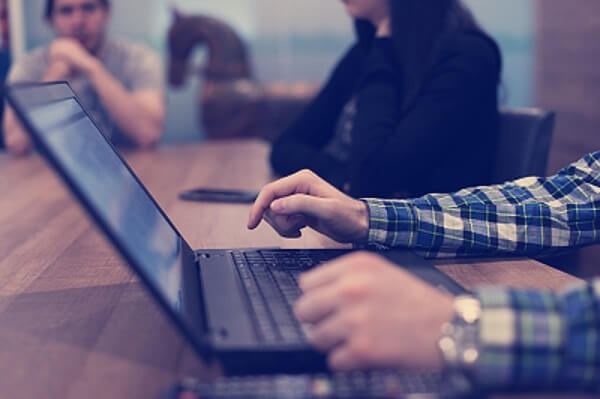Network programming allows programs to send or receive data through the network. In Python, network programming primarily uses the
socketmodule.
1. Basics of Network Programming
Network programming enables programs to send data to other programs through a network or receive data from other programs. In Python, the socket module is mainly used for this purpose.
2. TCP Server Example
import socket
# Create a socket object
server_socket = socket.socket(socket.AF_INET, socket.SOCK_STREAM)
# Bind the port
host = 'localhost'
port = 12345
server_socket.bind((host, port))
# Listen for connections
server_socket.listen(5)
print('Server listening on port:', port)
while True:
# Establish client connection
client_socket, addr = server_socket.accept()
print('Got connection from', addr)
# Receive message from client
msg = client_socket.recv(1024).decode()
print('Message from client:', msg)
# Send response
response = 'Thank you for connecting'
client_socket.send(response.encode())
# Close connection
client_socket.close()This simple TCP server listens on port 12345. When a client connects, it prints the client's address, receives a message, sends a response, and then closes the connection.
3. TCP Client Example
import socket
# Create a socket object
client_socket = socket.socket(socket.AF_INET, socket.SOCK_STREAM)
# Connect to server
host = 'localhost'
port = 12345
client_socket.connect((host, port))
# Send message
msg = 'Hello, server!'
client_socket.send(msg.encode())
# Receive response
response = client_socket.recv(1024).decode()
print('Response from server:', response)
# Close connection
client_socket.close()This simple TCP client connects to the server, sends a message, receives the server’s response, and then closes the connection.
4. UDP Server Example
import socket
# Create a socket object
server_socket = socket.socket(socket.AF_INET, socket.SOCK_DGRAM)
# Bind the port
host = 'localhost'
port = 12345
server_socket.bind((host, port))
print('Server listening on port:', port)
while True:
# Receive message from client
msg, addr = server_socket.recvfrom(1024)
print('Message from client:', msg.decode(), 'at', addr)
# Send response
response = 'Thank you for your message'
server_socket.sendto(response.encode(), addr)This simple UDP server listens on port 12345, receives messages from clients, and sends a response.
5. UDP Client Example
import socket
# Create a socket object
client_socket = socket.socket(socket.AF_INET, socket.SOCK_DGRAM)
# Send message
host = 'localhost'
port = 12345
msg = 'Hello, server!'
client_socket.sendto(msg.encode(), (host, port))
# Receive response
response, addr = client_socket.recvfrom(1024)
print('Response from server:', response.decode())
# Close connection
client_socket.close()This simple UDP client sends a message to the server, receives a response, and closes the connection.
6. Multi-threaded TCP Server Example
import socket
import threading
def handle_client(client_socket, addr):
print('Got connection from', addr)
msg = client_socket.recv(1024).decode()
print('Message from client:', msg)
response = 'Thank you for connecting'
client_socket.send(response.encode())
client_socket.close()
# Create a socket object
server_socket = socket.socket(socket.AF_INET, socket.SOCK_STREAM)
# Bind the port
host = 'localhost'
port = 12345
server_socket.bind((host, port))
# Listen for connections
server_socket.listen(5)
print('Server listening on port:', port)
while True:
# Establish client connection
client_socket, addr = server_socket.accept()
# Handle client connection in a new thread
thread = threading.Thread(target=handle_client, args=(client_socket, addr))
thread.start()This server uses multi-threading to handle multiple client connections, with each client handled in a separate thread.
7. Non-blocking I/O TCP Server Example
import socket
import select
# Create a socket object
server_socket = socket.socket(socket.AF_INET, socket.SOCK_STREAM)
# Set the socket to non-blocking mode
server_socket.setblocking(False)
# Bind the port
host = 'localhost'
port = 12345
server_socket.bind((host, port))
# Listen for connections
server_socket.listen(5)
print('Server listening on port:', port)
inputs = [server_socket]
outputs = []
while True:
readable, writable, exceptional = select.select(inputs, outputs, inputs)
for sock in readable:
if sock == server_socket:
# Establish client connection
client_socket, addr = server_socket.accept()
client_socket.setblocking(False)
inputs.append(client_socket)
print('Got connection from', addr)
else:
# Receive message from client
data = sock.recv(1024)
if data:
print('Message from client:', data.decode())
sock.send(data.upper())
else:
# Client disconnected
print('Client disconnected')
inputs.remove(sock)
sock.close()This non-blocking TCP server uses the select module to handle multiple client connections simultaneously, improving the program's responsiveness.
8. HTTP Protocol Example
from http.server import HTTPServer, BaseHTTPRequestHandler
class SimpleHTTPRequestHandler(BaseHTTPRequestHandler):
def do_GET(self):
self.send_response(200)
self.end_headers()
message = 'Hello, World!'
self.wfile.write(message.encode())
# Create HTTP server
server_address = ('localhost', 8000)
httpd = HTTPServer(server_address, SimpleHTTPRequestHandler)
print('Starting simple HTTP server...')
httpd.serve_forever()This simple HTTP server listens on port 8000 and responds with “Hello, World!” when it receives a GET request.
9. Sending HTTP Request Example
First, install the requests library:
pip install requests
Then, write the following code:
import requests
url = 'http://localhost:8000'
response = requests.get(url)
print('Response status code:', response.status_code)
print('Response content:', response.text)This code sends a GET request to the local HTTP server and prints the status code and content of the response.
10. WebSocket Programming Example
First, install the websockets library:
pip install websockets
Then, write the following code:
import asyncio
import websockets
async def echo(websocket, path):
async for message in websocket:
print(f'Received message: {message}')
await websocket.send(message)
# Create WebSocket server
start_server = websockets.serve(echo, 'localhost', 8765)
asyncio.get_event_loop().run_until_complete(start_server)
asyncio.get_event_loop().run_forever()This simple WebSocket server listens on port 8765 and echoes any message it receives.
11. WebSocket Client Example
import asyncio
import websockets
async def send_message():
uri = 'ws://localhost:8765'
async with websockets.connect(uri) as websocket:
message = 'Hello, WebSocket!'
await websocket.send(message)
print(f'Sent message: {message}')
response = await websocket.recv()
print(f'Received response: {response}')
asyncio.get_event_loop().run_until_complete(send_message())This simple WebSocket client connects to the server, sends a message, and receives a response from the server.



